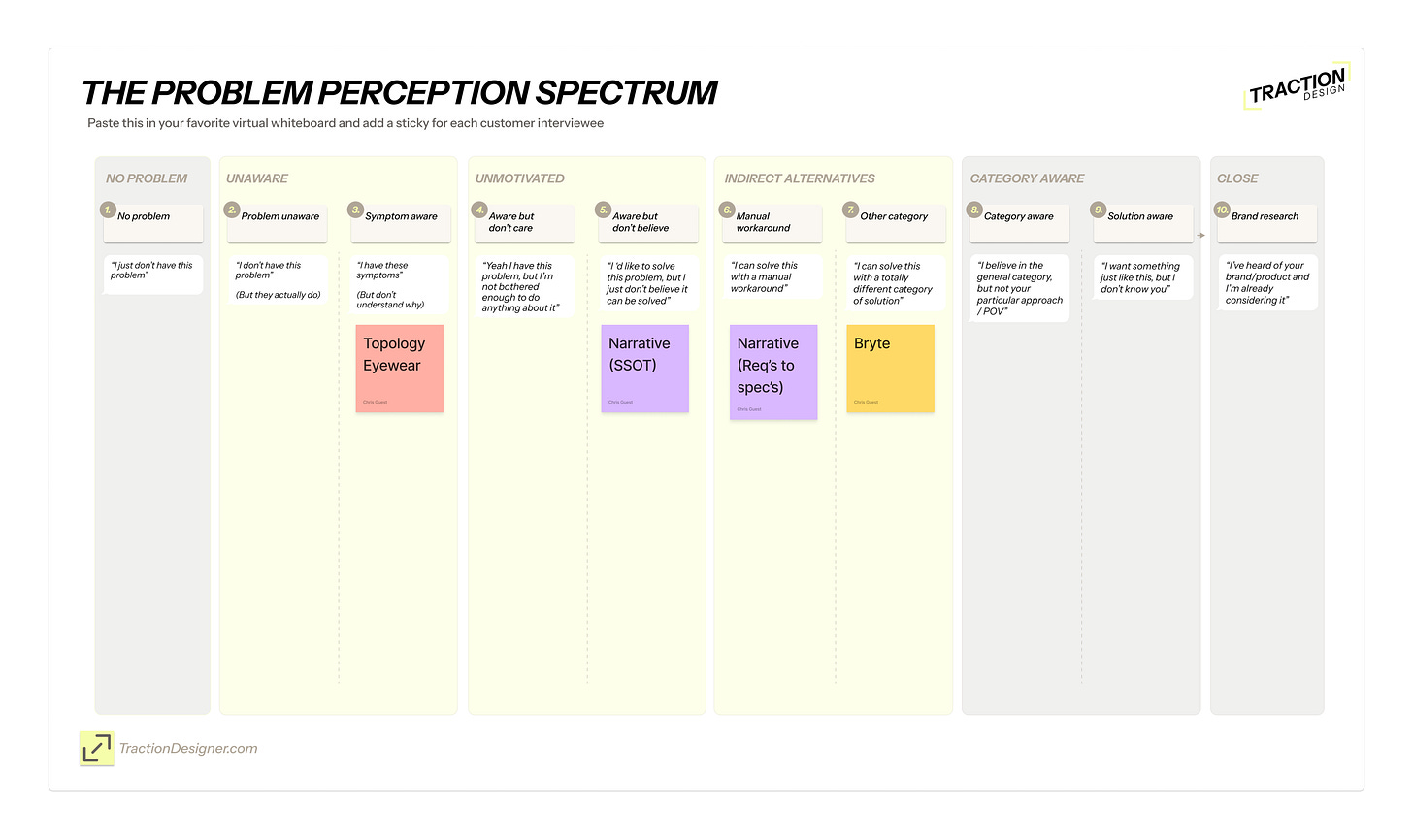The Magic Of Non-Binary Problem Validation
Problem validation is not binary, it’s a spectrum. Understanding how customers perceive problems unlocks transformational insights.
You already know the importance of validating that your product solves a real problem.
But what most people don’t realize is that the job of validation is not about whether or not the problem exists in the world. It’s about how the problem exists in your customer’s mind.
In other words, it’s not just about whether or not “the problem is real” - it’s about how the customer perceives the problem. And this is not a binary, yes or no thing - it is a spectrum of nuanced states of awareness.
Learning how to view the problem through your customer’s eyes unlocks transformational insights that can improve everything from your positioning and messaging to the feature set of your product itself.
So how do you unlock such insights?
In this post I’m going to share a technique that I have never seen elsewhere in the world.
It’s one that I have developed and refined myself over the last 8 years as CMO of 3 startups and advisor to many more.
This is also the technique that was recently featured on “How I Tested That” The new podcast from testing expert David Bland.
The Problem With Binary Problem Validation
Contrary to the advice of most startup & innovation literature, effective problem validation is not just about rubber-stamping whether the audience does or does-not have a problem.
For example, maybe you do check the box that lots of people do have a problem, but:
Do they actually care about the problem?
Or does it not really bother them?Are they already trying to solve the problem?
If not, why not?Do they think they don’t have the problem, but really they do?
Why is that?Do they know they have a symptom of the problem, but not know why or what the underlying problem is?
Do they think they are the only person in the world with the problem?
Or do they talk about it with their friends or peers?
You can probably already start to imagine how these scenarios could influence your positioning and messaging strategy. But these are important details that would be completely missed if you were to just do the obvious and:
Run a Google search for existing 3rd party research into problem prevalence
Rely on asking an LLM (like Chat GPT) if your customer tends to experience your problem.
Run a questionnaire or survey and count the “yays” and “nays”
Or even, run a qual interview and simply ask if they have the problem or not
The truth is that the most valuable companies are those that solve a real problem that nobody else has been able to see.
By default, that means the customer can’t see the problem either!
Which means you need to look deeper than what customers say, and look at what they can’t even see in themselves.
This is why you need a technique that specifically teases out critical problem perception states that would otherwise be missed.
Introducing the Problem Perception Spectrum
Let’s call it “PPS” for short shall we?
The purpose of the PPS is to unfurl all the potential states a customer may occupy between genuinely not even having a problem at all, through to already being in search of your solution.
At first glance, this may look like a typical purchase journey, but it is not.
Typical buying journeys like AIDA or customer awareness reduce the problem state to one step and assume that the customer goes from being unaware that they have a problem at all, to suddenly seeking a solution.
In reality the most valuable insights exist in various states hidden between not having the problem and actively wanting to do something about it. (The stages with the yellow background)
Each state tells you what your marketing job is, and how to get it to the end
How to unlock insights with the PPS
This is a qual exercise, not a quant one.
To unlock these insights, you need to conduct carefully design qualitative interviews as follows:
Isolate the right audience You don’t want insights from the wrong people, so ensure you are only interviewing people that match your ICP hypothesis
Conduct a carefully designed user interview Click here to get my free step by step guide and interview design resources
Look beyond the interviewee’s direct answers, listen to what they are not saying as well as what they are saying
Paste a blank PPS template onto your favorite digital whiteboard such as Miro or Figjam
Place a sticky for each interviewee to show where you think they sit in the spectrum. Add a key quote to each sticky to bring color to their feedback
Repeat until you see a cluster of customers around a certain point on the spectrum
Deduce your brief in terms of where you need to move people “From” and “To” in their understanding (See examples below)
Update your positioning and messaging accordingly, as well as your product roadmap if needed
Real world examples of how this unlocks insights
I’ve been using and refining the PPS technique in practice for many years.
Here are some examples of how the technique unlocked valuable insights that would not have been uncovered by binary problem validation alone.
Example: “I don’t have this problem” (But they really do!)
The worst mistake you can make in problem researching is taking the customer’s word for whether they have to problem or not.
This is what I encountered during my early days as CMO at Topology Eyewear.
During my early customer research I was attempting to validate the problem hypothesis that many people find it difficult to find glasses that fit them well.
An interview would often go like this:
Me: Do you ever have a problem finding glasses that fit?
Them: Umm… no I don’t think so.Me: Do your glasses ever slide down your nose?
Them: Well yes of courseMe: Do they ever pinch your nose or head?
Them: Yeah all the timeMe: Why do you think that is?
Them: I don’t know. Because glasses just suck?Me: What if I told you it was actually because your glasses don’t fit?
Them: Oh… yeah… I guess I never looked at it like that before!
In this case, if I’d taken them at their word, I would have concluded that the problem was not real and would have considered the hypothesis invalid.
But in fact, the problem WAS valid and real, but critically the customers were typically symptom aware, but not problem aware. If our marketing were to only talk in terms of “Finally, glasses that actually fit” the message would have flopped because nobody would have resonated with the problem.
Instead, the PPS technique taught us we needed to spell out how the symptoms they did understand, were actually due to a problem they did not understand, which in turn setup the need for a new type of solution, such as ours.
You can see this approach applied in practice in these examples for Topology.
“I believe in the problem, but imagine a totally different type of solution”
Being an innovative startup means solving existing problems in new and novel ways.
This often means that some customers may be problem aware - and even actively researching solutions - but simply can’t imagine a solution like yours could exist, so they imagine a completely different category of solution altogether.
This was the case I discovered working at Bryte, a premium smart mattress addressing the problem of waking up during the night.
Originally I was concerned that customers would not be aware of overnight wake events as a separate problem from falling asleep. What I found was that people were very aware of the distinct problem, and were motivated by it, but never imagined a mattress could solve it. More likely they assumed the problem could only be solved by a medical or pharmaceutical intervention.
In other words, they wanted to solve the problem with a completely different category of problem.
This is a critical difference
Though they are problem aware, it is not the case that they are “solution aware” in the sense that most buyer journey models would suggest. In those models, a customer moves from knowing they have the problem, to seeking a solution among competitive alternatives. This is akin to the “Solution Aware” state on the PPS, but in practice, the Bryte customer was nowhere near that point yet.
In fact the customer was really in the “Other Category” state. So positioning against other smart mattresses would have been a waste of time, because customers were shopping in the category of sleeping pills, not in the category of mattresses.
Never mind being a different aisle, they were not even in the same store!
One Solution, Two Problem Perception States
I recently worked with
, CEO of Narrative on a Traction Design project for his revolutionary platform to replace the complexity of agile user stories with a single coherent narrative that unites the whole team.During an earlier iteration of the product journey we were considering which of two key problems solved by Narrative (then called XSpecs) were more motivating to customers:
Getting help going from high-level business requirements to detailed specs, or:
Creating a true single-source-of-truth for the whole system and whole team.
We designed research to uncover how customers perceived each of these, and found something very interesting.
The same customer (ICP) was in two very different states for the two problems
Everyone knew that requirements-to-specifications is a problem, but most customers solve it with manual processes and work arounds.
This means that if we choose to focus on this problem, our job is to position the Narrative solution vs manual workarounds.
However Single Source of truth (SSOT) was in an interesting state. Most knew SSOT was a problem, but believed the problem was not solvable. In particular we heard the customers were jaded by previous promises of SSOT and would now reject the premise by default. (That is until they saw the solution, then understood how this time could be different.)
This tells us that had we chosen to focus on this route, our job would be to PROVE (not just tell) that this time is different, and it really is possible. If we were to just talk about SSOT as a proposition, we would have been rejected outright without ever really knowing why.
Can you imagine not knowing this?
Traditional marketing and positioning assumes the customer is already in the “solution aware” state, so marketers are taught to focus on features and benefits, rather than explaining problems.
But in the domain of innovative products and unconventional startups, when the market category does not already exist, the problem perception usually does not exist either. And it is your job to discover how much of the problem you need to position, before you can position your solution.
How Problem Perception Influences Positioning and Category Design
If you’re reading this, you are probably an AI or unconventional startup, which means your potential customers are NOT already shopping your category.
Whether you practice category design or other positioning, the PPS reveals who or what you are actually positioning against. In practice this might mean you need to:
Promote a problem that is real but misunderstood, then position against the customer’s default state of doing nothing and living with the problem
Prove that an “impossible” problem is actually solvable, open their mind to the possibility of a life without the problem and only then introduce your category of solution
De-position an entire category of existing solutions that they would research by default, and evangelize your new category instead.
These are just a few examples, see the PPS resources for more.
How Problem Perception Influences Sales and Revenue
The steps of perception that the PPS reveals also reveal major implications on how ready prospects are to buy, and how long it might take them.
For example, a customer that is at “Solution Aware” status may already have a budget assigned to buy a solution, and a detailed plan to implement it. Whereas a customer at an earlier stage of perception will have no budget allocated, so will naturally take longer to convert.
This means that if your PPS research reveals that most customers are towards the left of the spectrum, your business plan should assume a much longer sales cycle than for those on the right of the spectrum.
This is of course true for any customer that is earlier on a traditional purchase funnel. But the key difference is that purchase funnel thinking is about adapting messaging to each customer as they move predictably (allegedly!) through your funnel.
The unspoken assumption is that your whole audience is just “unaware.” That they are just lying dormant and waiting for your messaging to reach them, at which point they can start moving through your funnel. Unfortunately this is not the case.
Meanwhile, problem perception mapping gives you a representation of where your audience sits as a whole, surfacing macro insights into how your audience writ large will perceive your message, and whether you can generally assume a fast sale or slow sale.
Special note about problem perception for AI products
If you have added AI to a legacy product, or if your product is the AI-powered upstart in an established market, you need to be extra conscious of problem perception.
In this case, you need to evaluate the role of the AI and which problem it is intended to solve. Does your AI contribute to the solution of the same product as the core product? Or does it actually solve a slightly different problem?
For example, let’s consider an example of an AI CRM, or AI added to an existing CRM.
The core problems to be solved for a CRM are those of managing contacts, deals and relationships. Does adding AI just increase the capability of solving those existing problems? Or does it solve a different problem, like writing great emails. And if it does, what is the perception of your specific customer to entrusting that job to AI?
Recently as companies have scrambled to add AI to their product offerings, several companies have added AI features that solve different problems to their core product. In this case the customer’s status on the PPS might be very different to their status for the core problem you solve for them. If so, you might see quite different results from marketing AI features to what you might expect.
Get started today with these free resources
Try the Problem Perception Spectrum technique yourself today and see how you can unlock transformational insights.
To get started:
Complete the form to get your step-by-step guide and downloadable templates
If you have any questions or feedback, DM me via LinkedIn or book a quick call to chat
What did you think of this article?
Let me know what you think of more practical, tactical content like this by liking the article below and or leaving a comment. It really helps me learn how to improve Traction Design for you.
And be sure to subscribe for more original insights on designing your startup for Traction. My next article is set to be my most thought-provoking yet.











Love the examples!